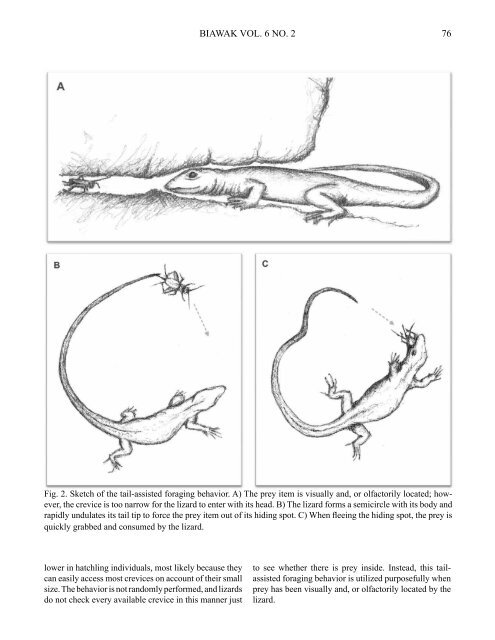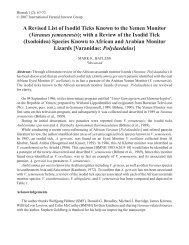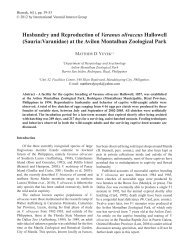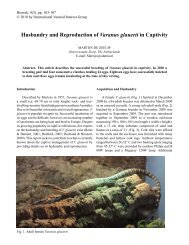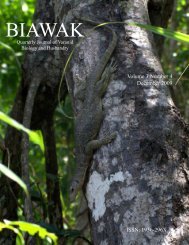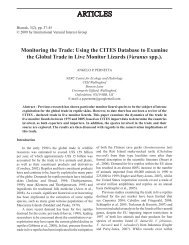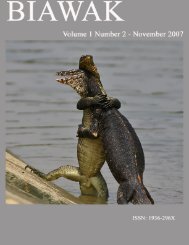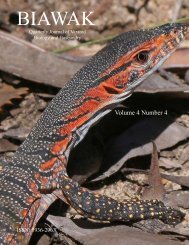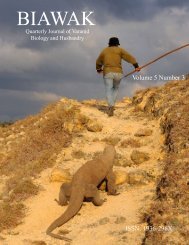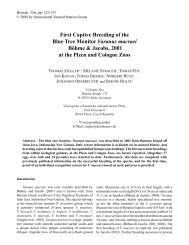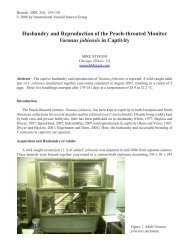75PATANANT - TAIL-ASSISTED FORAGING BEHAVIOR IN VARANUS KINGORUMFig. 1. Varanus kingorum have extraordinarilylong tails which they can use to extractprey from otherwise unreachable crevices.have averaged around 5.0 cm and 9.5 cm respectively,and therefore fall within the ranges reported byothers (Eidenmüller, 1999; Retes & Bennett, 2001;Eidenmüller, 2003).Adult pairs are kept in adequately sized enclosureswith a thick layer (ca. 15-25 cm) of mostly inorganicsubstrate such as sand of varying grain sizes with asmaller share of organic matter. Heat-tolerant plantssuch as Callistemon sp., cork tubes, rocks, and stacksof flat wood arranged to imitate rock crevices thatwould be used in the wild, are also provided. The woodand rock stacks increase usable surface area, createartificial crevices, and depending on their constructionand arrangement, offer tight-fitting refuge sites withdifferent humidity levels and temperature gradients. Theheights of these artificial crevices range from 1.5 cm onone side, narrowing down to 0 cm on the other.Their diet consists of cockroaches (Blaptica dubia),house and field crickets (Acheta domesticus, Gryllusassimilis) and the occasional baby mouse, which havenot been accepted with gusto by most individuals ofV. kingorum in the author’s collection. Cockroachesare offered from forceps or placed in a food bowl, butcrickets are released into the enclosure for the lizards tohunt freely. Varanus kingorum is a fast and agile hunterthat preferably grabs its prey by the head and consumesit in typical varanid fashion.Behavioral ObservationsNot all crickets introduced to the enclosures areconsumed immediately and some take refuge in narrow,dark, and humid locations. Crickets are relatively easilycaptured by the lizards from within cork tubes and aresometimes dug out from under rocks and wood slabsresting atop the sand substrate. However, the lizards facea problem when prey items seek refuge inside crevicestoo narrow for them to enter with their heads (Fig. 2a).This sometimes occurs when crickets hide in the narrowends of the crevices created by the wood or rock stacks.A clever solution to this problem has been observedin multiple V. kingorum of both sexes and all age classes.If a lizard realizes it cannot reach the cricket with itsjaws, it switches to a different tactic. First, the lizardbacks off, forming a semicircle with its body, with thetail tip facing the crevice where the cricket is located. Itthen begins to rapidly undulate the tip of its tail to forcethe cricket out of its safe hiding spot in the narrow part ofthe crevice (Fig. 2b). This works very efficiently, and inmost cases the crickets are distracted by the fast movingtail and flee the crevice. The escape route for the cricketis defined by the body positioning of the lizard, whichforces it to run directly towards the lizard´s head, whereit is then quickly grabbed and consumed (Fig. 2c). Thisall occurs inside the crevice provided it is large enoughto accommodate the lizard. If the prey hides undersmaller objects, the lizards perform the same behavior,sometimes reaching under the object with their tailsfrom one side with the head on the other side waitingfor the prey to emerge. The entire process can occurvery quickly and be over in a matter of seconds.DiscussionAs a species, V. kingorum appears to display thisbehavior instinctively, as individuals of all age classes,from hatchlings to adults have been observed huntingcrickets in this manner. The frequency of its usage was
BIAWAK VOL. 6 NO. 276Fig. 2. Sketch of the tail-assisted foraging behavior. A) The prey item is visually and, or olfactorily located; however,the crevice is too narrow for the lizard to enter with its head. B) The lizard forms a semicircle with its body andrapidly undulates its tail tip to force the prey item out of its hiding spot. C) When fleeing the hiding spot, the prey isquickly grabbed and consumed by the lizard.lower in hatchling individuals, most likely because theycan easily access most crevices on account of their smallsize. The behavior is not randomly performed, and lizardsdo not check every available crevice in this manner justto see whether there is prey inside. Instead, this tailassistedforaging behavior is utilized purposefully whenprey has been visually and, or olfactorily located by thelizard.


